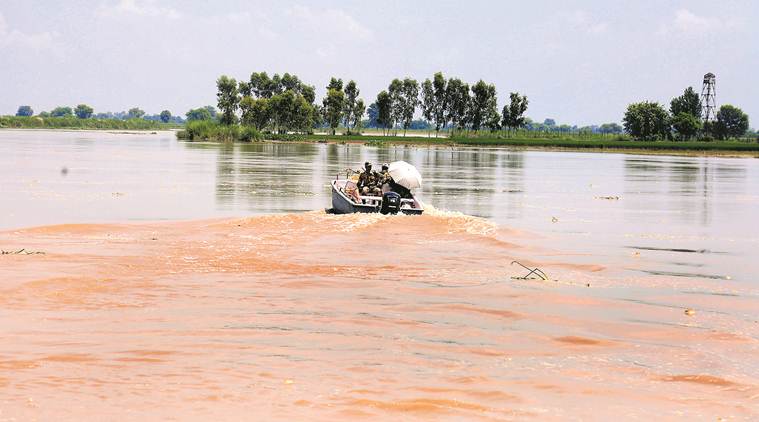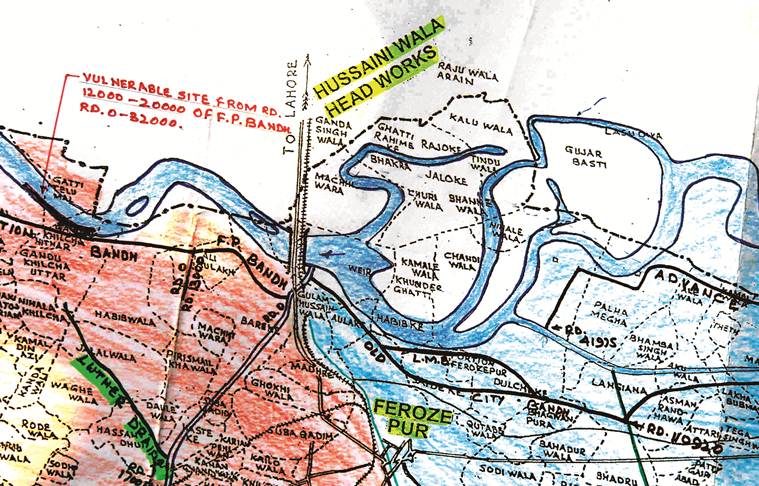- India
- International
Polluted by Pakistan’s tanneries, dirty flows the Sutlej in Punjab border villages
The tanneries are situated in Pakistan’s Kasur district famous for its ‘Kasuri Jutti’ and other leather products. The district has over 300 tanneries.
 A BSF team on patrol where the Sutlej enters India from Pakistan at Tendiwala in Ferozepur. (Express photo: Gurmeet Singh)
A BSF team on patrol where the Sutlej enters India from Pakistan at Tendiwala in Ferozepur. (Express photo: Gurmeet Singh)
It is not being easy a resident of village Tendiwala, one of more than 17 villages in Punjab’s Ferozepur located on the right bank of Sutlej along the Indo-Pakistan border.
Ask Parkash Singh, a farmer from the village which bore the brunt of flooding following release of excess water into the river by Pakistan. The neighbouring country had released the water in Sutlej creek, or the Kasur Nullah as it is locally known.
Parkash Singh says that Pakistan released a huge quantity of toxic waste from its tanneries into the
Satluj that enters Pakistan via Harike Headworks before turning back into India via Kasur Nullah.
 Index of the river on the India-Pakistan border in Ferozepur. (Express photo: Gurmeet Singh)
Index of the river on the India-Pakistan border in Ferozepur. (Express photo: Gurmeet Singh)
The tanneries are situated in Pakistan’s Kasur district famous for its ‘Kasuri Jutti’ and other leather products. The district has over 300 tanneries.

Parkash Singh’s 7-acre farm land is located just 40 feet from the Sutlej. “The stench sometimes was so bad that we felt like shifting to some other place for some time,” he says.
“You can imagine how bad the situation is as sometimes you can see a major portion of the water in Nullah being brownish red in colour due to all the water released from tanneries in Kasur,” says Amar Singh, sarpanch of village Madre.
Kasur is located about 17 km from Hussaniwala border located in Ferozepur district of Punjab. The creek enters Indian via Tendiwala.
Pakistan on August 20 had alleged that excess release of water from India was posing flood threat in many villages of Kasur. However, on August 22, deputy commissioner, Ferozepur, Chander Gaind clarified that India had not released any water to Pakistan. “In fact, it is the natural course of river that water first goes towards Pakistan via Harike Headworks and then comes back to India. However, Pakistan has created more trouble for flood-affected villages of Punjab by releasing more water via Kasur Nallah in which they have also added polluted water of tanneries located in that part only”.
At that time several districts in Punjab affected by floods after excess water was released from Bhakra dam by the Bhakra Beas Board Management (BBMB).
Sardul Singh, a resident of village Bhakra says, “Polluted water from Kasur side is nothing new. We have been seeing this for past several decades now. Over the years, more tanneries have come up in Kasur thereby aggravating our problems”.
“The foul smell continues to emanate from the water for most part of the year. We get some temporary relief in the rainy season (June-September) when the polluted water gets diluted,” he added.
Tendiwala village sarpanch Jagir Singh says, “Now, nearly 50,000 cubic per second (cusecs) of water is flowing in the river and hence the stench is subdued. Once the monsoon is over and the flow in the creek is not more than 1000 cusecs, you cannot even stand near the river. We don’t use the creek water for drinking purposes, but it ultimately merges into Sutlej and harms our fields, and in turn us, directly or indirectly.”
About 17 feet of the embankment on the Sutlej had eroded due to excess flow in Kasur Nullah on August 23 leading to the farms getting submerged.
The Kasur Nullah passes through 12 villages including Tendiwala, Kaluwala, Hussainiwala, Gatti Rajoke, Shameke, and Kilchain.
Mangal Singh, sarpanch of Basti Chhinewala says, “ Sutlej already gets polluted, including with industrial effluents and sewerage, at several points in Himachal Pradesh, and Ludhiana, Nakodar and Dharamkot in Punjab. The extremely polluted water that Pakistan releases into it becomes an added burden on the river and it affects us who live on its banks”.
Master Gurbaksh Singh, a farmer who has land close to the river, said that dirty water from Kasur Nullah is affecting quality of ground water too.
SS Dhaliwal, executive engineer, PPCB, said, “We do monthly sampling of Sutlej water under National Water Monitoring programme from 16 points. Hussainiwala upstream, which is 10 km away from the point from where water is entering Pakistan, is the closest point where testing is done. So far no other point has been chosen for monthly testing. At that point, water quality is C as per DBU (designated best use) standards.”
The pom C grade DBU means that drinking water sources need conventional treatment followed by disinfection. DBU norms have been set by Central Pollution Control Board.
DC Chander Gaind admitted that polluted water from Kasur is an issue but said he had no details if the matter was flagged in the past.
The drainage department officials claimed that the issue had once been raised in Parliament and a central team had also visited the area. But after that the matter was put in cold storage.
The area falls in Ferozepur parliamentary constituency, represented by Shiromani Akali Dal for more than 20 years. SAD chief Sukhbir Singh Badal is currently representing Ferozepur in Lok Sabha. He has so not visited any of the villages affected by the floods.
Charanjeet Singh Brar, political advisor to Sukhbir Badal, said, “We will get this issue examined and will raise this issue at whatever level we can.”
Apr 27: Latest News
- 01
- 02
- 03
- 04
- 05








































